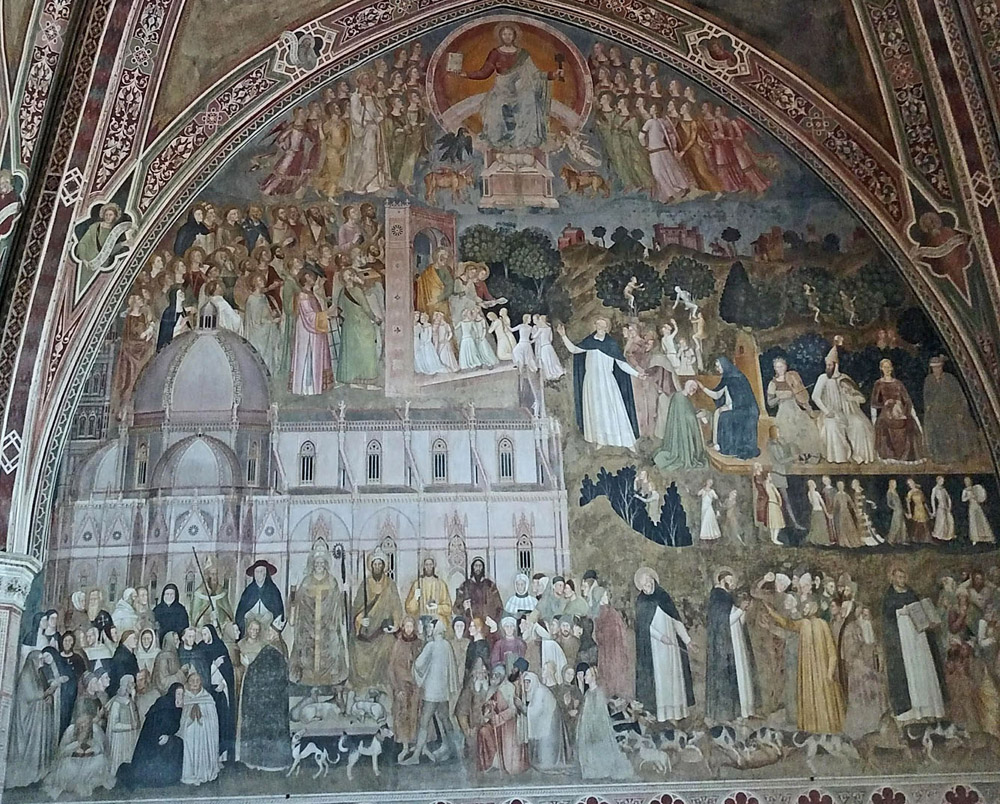Andrea di Bonaiuto da Firenze, The Church Militant and the Church Triumphant

1366-67
Fresco
Chapter House ("The Spanish Chapel")
Church of Santa Maria Novella, Florence
This is the lower image of two on the right side of the chapter house. It is called "The Triumph of Doctrine" by a commercial website and "The Church as the Path to Salvation" by the usually authoritative Web Gallery of Art. But the title given by the label in the chapter house is "The Church Militant and the Church Triumphant," and that seems the most consistent with the actual content of the image. In Catholic teaching, the church on earth is called "militant" because its people have to work against the designs of Satan and lead themselves and others to Heaven, where they form the "Church Triumphant" (Catholic Encyclopedia, s.v. "Church").
In the bottom register, a pope and bishops on the left preside over the generality of the faithful. A Wikipedia article (retrieved 2020-04-14) says, without documentation, that this pope is Benedict XI, the first Dominican pope, and that the man on his right is Cardinal Niccolò Albertini, also a Dominican. The poet Petrarch is said to be the man in the brown hood standing below Albertini's right hand.
In the center of the bottom register, a Dominican saint in his black and white habit invites one person of the people on the left to come over to the right side, perhaps to join the work of the Dominicans. The rod in his hand, pointing to the right, signifies the invitation. In the next group to the right a Dominican saint, most likely Peter of Verona, preaches to a hostile crowd. His gesture of counting on fingers is a conventional signifier of teaching about God and specifically about the Trinity. (See this page for other examples of this gesture.) Then a third Dominican on the far right preaches to another crowd with a book of scripture. All this work is punningly symbolized by the "dogs of the Lord," in Latin domini canes, along the bottom of the image.
In the middle register the Dominican in the center succeeds in calling men and women from the secular life, represented on the right by dancers and musicians, to the salvation represented on the left by the people in white baptismal garments entering the gate to join those headed for Heaven. His work is symbolized by the men gathering fruit in the trees behind him.
The people inside the gate include saints such as Lawrence, who holds his gridiron in the rank closest to the viewer, and possibly Catherine of Siena, the nun standing farther left in that rank.
In the top register, Jesus Christ is pictured both as a human figure in the rainbow of Revelation 4:3 and as the "Lamb of God" on an altar flanked by symbols of the four evangelists. In his hands the human figure holds the book and keys that the traditional Traditio Legis genre pictures him giving to Saints Paul and Peter. In the crowd of saints and angels on his right, one crowned female figure in white stands out. Most likely, this is the Virgin Mary.
View this image and the one above it (St. Peter) in full resolution.
Read more about imagery of the Church.
Photographed at the site by Richard Stracke, shared under Attribution-NonCommercial-ShareAlike license.